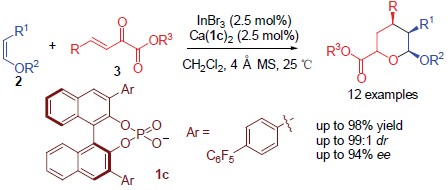[1] For selected examples of natural and bioactive unnatural products containing the dihydropyran and tetrahydropyrans moiety, see: (a) Westley, J. W.; Evans, R. H.; Williams, T.; Stempel, A. J. Chem. Soc. D 1970, 71; (b) Pettit, G. R.; Herald, C. L.; Doubek, D. L.; Herald, D. L.; Arnold, E.; Clardy, J. J. Am. Chem. Soc. 1982, 104, 6846; (c) Higa, T.; Tananka, J.; Komesu, M. Gravalos, D. C.; Puentes, J. L. F.; Bernardinelli, G.; Jefford, C. W. J. Am. Chem. Soc. 1992, 114,
7587; (d) Kang, D. G.; Choi, D. H.; Lee, J. K.; Lee, Y. J.; Moon, M. K.; Yang, S. N.; Kwon, T. O.; Kwon, J. W.; Kim, J. S.; Lee, H. S. Planta Med. 2007, 73, 1436; (e) Xu, Z. L.; Li, Y. Y.; Xiang, Q.; Pei, Z.; Liu, X. L.; Lu, B. T.; Chen, L.; Wang, G. L.; Peng, J. Y.; Lin, Y. C. J. Med. Chem. 2010, 53, 4642.
[2] (a) Murata, M.; Yasumoto, T. Nat. Prod. Rep. 2000, 17, 293; (b) Yasumoto, T.; Bagnins, R.; Randal, J. E.; Banner, A. H. Nippon Suisan Gakkaishi 1971, 37, 724; (c) Yasumoto, T.; Bagnins, R.; Vernoux, J. P. Nippon Suisan Gakkaishi 1976, 42, 359; (d) Yasumoto, T.; Nakajima, I.; Bagnis, R.; Adachi, R. Nippon Suisan Gakkaishi 1977, 43, 1021; (e) Yokoyama, A.; Murata, M.; Oshima, Y.; Iwashita, T.; Yasumoto, T. J. Biochem. 1988, 104, 184; (f) Nicolaou, K. C.; Aversa, R. J.; Jin, J.; Rivas, F. J. Am. Chem. Soc. 2010, 132, 6855.
[3] Lin, Y.; Wu, X.; Feng, S.; Jiang, G.; Luo, J.; Zhou, S.; Vrijmoed, L. L. P.; Jones, E. B. G..; Krohn, K.; Steingrover, K.; Zsila, F. J. Org. Chem. 2001, 66, 6252.
[4] Pereira, A. R.; McCue, C. F.; Gerwick, W. H. J. Nat. Prod. 2010, 73, 217.
[5] (a) Kim, H.; Hong, J. Org. Lett. 2010, 12, 2880; (b) Hajare, A. K.; Ravikumar, V.; Khaleel, S.; Bhuniya, D.; Reddy, D. S. J. Org. Chem. 2011, 76, 963; (c) Yang, Z.; Xie, X.; Jing, P.; Zhao, G.; Zheng, J.; Zhao, C.; She, X. Org. Biomol. Chem. 2011, 9, 984; (d) Pabbaraja, S.; Satyanarayana, K.; Ganganna, B.; Yadav, J. S. J. Org. Chem. 2011, 76, 1922; (e) Gesinski, M. R.; Rychnovsky, S. D. J. Am. Chem. Soc. 2011, 133, 9727.
[6] (a) Nicolaou, K. C.; Snyder, S. A. Classics in Total Synthesis II, Wiley-VCH, Weinheim, 2003; (b) Smith, III A. B.; Fox, R. J.; Razler, T. M. Acc. Chem. Res. 2008, 41, 675.
[7] (a) Evans, D. A.; Johnson, J. S. J. Am. Chem. Soc. 1998, 120, 4895; (b) Evans, D. A. Olhava, E. J.; Johnson, J. S.; Janey, J. M. Angew. Chem. Int. Ed. 1998, 37, 3372; (c) Evans, D. A.; Johnson, J. S.; Olhava, E. J. J. Am. Chem. Soc. 2000, 122, 1635.
[8] (a) Thorhauge, J.; Johannsen, M.; J鴕gensen, K. A. Angew. Chem. Int. Ed. 1998, 37, 2404; (b) Audrain, H.; Thorhauge, J.; Hazell, R. G.; J鴕gensen, K. A. J. Org. Chem. 2000, 65, 4487. (c) Zhuang, W.; Thorhauge, J.; J鴕gensen, K. A. Chem. Commun. 2000, 459; (d) Audrain, H.; J鴕gensen, K. A. J. Am. Chem. Soc. 2000, 122, 11543.
[9] (a) Gademann, K.; Chavez, D. E.; Jacobsen, E. N. Angew. Chem. Int. Ed. 2002, 41, 3059; (b) Gao, X.; Hall, D. G. J. Am. Chem. Soc. 2003, 125, 9308.
[10] (a) Desimori, G.; Faita, G.; Mella, M.; Piccinini, F.; Toscanini, M. Eur. J. Org. Chem. 2007, 1529; (b) Desimoni, G.; Faita, G.; Toscanini, M.; Boiocchi, M. Chem. Eur. J. 2007, 13, 9478.
[11] Zhu, Y.; Xie, M.; Dong, S.; Zhao, X.; Lin, L.; Liu, X.; Feng, X. Chem. Eur. J. 2011, 17, 8202.
[12] (a) Zhou, J.; Tang, Y. Org. Biomol. Chem. 2004, 2, 429; (b) Zhu, Y.; Chen, X.; Xie, M.; Dong, S.; Qiao, Z.; Lin, L.; Liu, X.; Feng, X.; Chem. Eur. J. 2010, 16, 11963.
[13] (a) Lv, J.; Li, X.; Zhang, L.; Luo, S.; Cheng, J.-P. Org. Lett. 2010, 12, 1096; (b) Lv, J.; Zhang, L.; Zhou, Y.; Nie, Z.; Luo, S.; Cheng, J.-P. Angew. Chem. Int. Ed. 2011, 50, 6610; (c) Lv, J.; Zhang, L.; Hu, S.; Cheng, J.-P.; Luo, S. Chem. Eur. J. 2012, 18, 799; (d) Chen, L.; Zhang, L.; Lv, J.; Cheng, J.-P.; Luo, S. Chem. Eur. J. 2012, 18, 8891.


